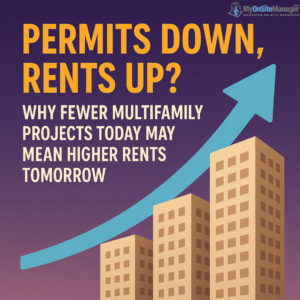As multifamily housing permits continue to fall in key U.S. cities, experts warn that today’s slowdown in construction could spell higher rents in the near future.
A recent analysis by Realtor.com published on AZ Big Media raises red flags for renters and real estate professionals alike. In 2024, the number of new multifamily permits issued in the top 50 U.S. metro areas dropped to 294,000—well below the 318,000 permits seen at the height of the pandemic in 2020. And this isn’t just a temporary blip. It reflects a larger shift in the housing development landscape driven by rising costs, interest rate hikes, and economic uncertainty.
Full article source: AZ Big Media – Could Fewer Multifamily Permits Today Mean Costlier Rents Ahead?
The Shortfall in New Construction
Despite the recent dip in average rents in many U.S. cities, experts warn that this period of relief may be short-lived. The lack of new construction today could lead to a worsening supply-demand imbalance, especially in fast-growing metros where the population continues to rise.
Key Statistic:
-
The U.S. is still short 3.8 million housing units, according to Realtor.com’s Chief Economist Danielle Hale.
Even though vacancy rates have ticked up slightly due to softening demand, a sustained drop in new apartment starts will likely reverse that trend in the coming years.
Cities Most at Risk of Future Rent Increases
The data reveals a concerning pattern: many metros currently experiencing rent growth are also seeing steep declines in multifamily permitting—an early warning sign that demand could soon outstrip supply.
Cities where permits are down and rents are rising:
-
New York City: Permits fell 9.5%, yet rent jumped 6.8% YoY
-
Kansas City, MO: Permits down 6%; rent up 6%
-
Detroit, MI: Permits down 11.6%; rent up 3.6%
-
Washington D.C., Boston, San Jose, Charlotte, St. Louis, and others also showed similar trends
These areas are at particular risk of rent spikes if construction doesn’t rebound.
Where Permit Activity Is Helping Renters
On the other hand, markets that are outperforming their historical permit averages are seeing a drop in rents. Increased development is helping keep rental costs in check.
Examples:
-
Cleveland, OH: Permits up 37.9%; rent down 3%
-
Cincinnati, OH: Permits up 29.9%; rent down 3.3%
-
Birmingham, AL: Permits up 22.1%; rent down 5.4%
These cities show that aggressive permitting strategies can help ease affordability pressures for renters.
The Apartment Size Factor
A closer look at rental trends by unit size suggests that larger units are faring better than smaller ones.
Five-year rent growth by unit size:
-
Two-bedroom units: +18.3%
-
One-bedroom units: +14.3%
-
Studios: +9.7%
In the most recent data, however, studio and one-bedroom rents declined slightly, signaling a temporary shift in demand as renters continue to look for more space—likely a lingering effect of pandemic-era lifestyle changes.
Federal Employment Cities: A Mixed Bag
Cities with a high number of federal employees (e.g., Washington D.C., San Diego, Oklahoma City, Baltimore) saw divergent rental trends:
-
Washington D.C.: Rents up 3.3%
-
San Diego, CA: Rents down 6%
This suggests that local employment trends, cost of living, and new supply all interact uniquely in each market.
What’s Causing the Permit Decline?
There are multiple factors contributing to the slowdown in multifamily permitting:
-
High interest rates: Developers face steeper borrowing costs
-
Inflation: Increased material and labor costs affect project feasibility
-
Uncertainty: Fluctuating demand and economic instability make developers cautious
-
Permitting delays: Some cities are dealing with regulatory slowdowns
According to Redfin, the number of permits per 10,000 residents has dropped to 12.4 units, representing a 27% decline from pandemic highs.
What This Means for Renters and Investors
If this downward permitting trend continues, renters could experience:
-
Higher prices in the next 12–24 months, especially in underbuilt cities
-
Fewer options, as available rental stock tightens
-
Delayed relief from affordability issues, unless permitting rebounds or interest rates fall
For real estate professionals and investors, this is a critical window to track local permitting activity as a leading indicator for future rent growth potential.
Final Thoughts
Although rents have cooled in many areas, today’s permitting slowdown is tomorrow’s affordability crisis. Without a strong pipeline of new units—especially in metros already dealing with housing shortages—rent prices are poised to rise again.
Whether you’re a renter, investor, or housing advocate, this trend deserves close attention. And as always, the cities that build today are the ones that stay affordable tomorrow.
Original Source: AZ Big Media – Could Fewer Multifamily Permits Today Mean Costlier Rents Ahead?

